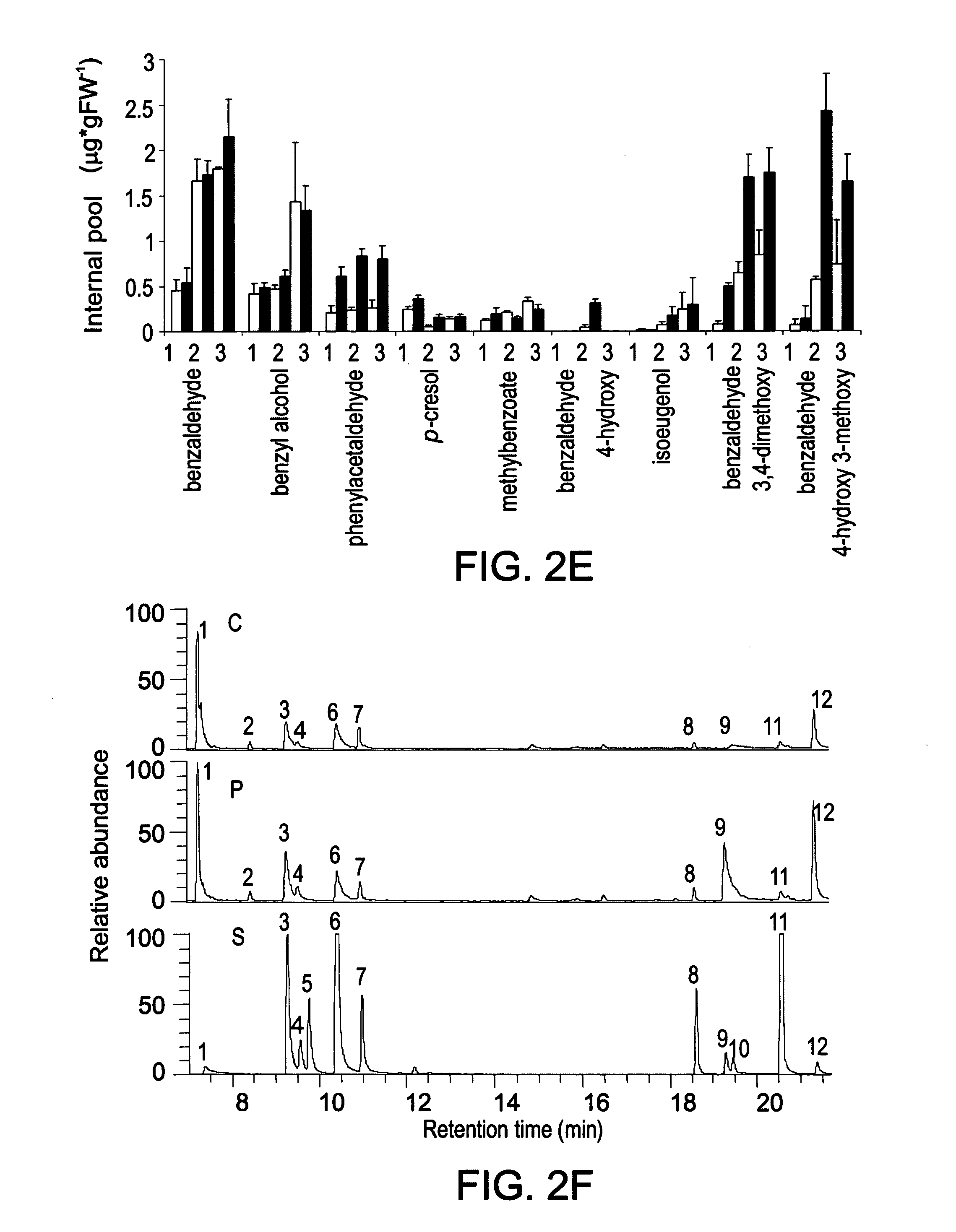Methods of modulating production of phenylpropanoid compounds in plants
a technology of phenylpropanoid compounds and plants, applied in plant products, tissue culture, peptides, etc., can solve the problems of volatile production, restrict metabolic flow, and limited floral scent engineering, and achieve the effect of enhancing the production of phenylpropanoid compounds
- Summary
- Abstract
- Description
- Claims
- Application Information
AI Technical Summary
Benefits of technology
Problems solved by technology
Method used
Image
Examples
example 1
Pap1 Expression in Petunia Leads to Increased Pigmentation and Scent
[0199]Materials and Experimental Procedures
[0200]Plant Material
[0201]Petunia hybrida ‘Blue Spark’ was used for the generation of transgenic plants. Plants were grown in a greenhouse under 22° C. / 16° C. day / night temperatures and natural photoperiod. Unless otherwise indicated, petunia flowers were collected at 2300 hours on the first night post-anthesis. For developmental analysis, buds and flowers were analyzed 120, 72 and 24 hours pre-anthesis (stages-5, -3 and -1, respectively), and 24, 48 and 72 hours post-anthesis (stages 1, 2 and 3, respectively). For day / night experiments, tissue was collected at two time points: 1100 hours and 2300 hours.
[0202]Construction of Chimeric Gene and Plant Transformation
[0203]Pap1 (GenBank accession no. AF325123) coding for Myb transcription factor (SEQ ID NO: 1) was cloned from Arabidopsis ‘Colombia’ DNA using PCR primers 5′-ATCTGCAGACTTATACCTTTTACAATTTGTTTA-3′ (SEQ ID NO: 3) and ...
example 2
[0222]Pap1 Expression Leads to Increased Phenylalanine Utilization and Metabolic Flux in Petunia
[0223]Materials and Experimental Procedures
[0224]As described in detail in Example 1, hereinabove.
[0225]Results
[0226]To gain insight into the metabolic flux within the phenylpropanoid pathway in transgenic vs. control flowers and to assess substrate availability for volatile production, analysis of the levels of pathway intermediates was carried out. The internal pool size of phenylalanine (Phe) oscillated greatly between day and night in control flowers, with peak accumulation occurring at night (FIG. 5A). However, this nocturnal increase in Phe level was not observed in Pap1-transgenic flowers. In fact, night-time Phe levels were five- to sevenfold lower in transgenic vs. control flowers, whereas daytime Phe levels were only slightly affected (FIG. 5A). Levels of cinnamic and coumaric acid were similar in Pap1-transgenic and control flowers (FIGS. 6A-B).
example 3
Abolishment of Nocturnal Rhythms of Scent Production Through Increased Phe Availability in Pap1 Transgenic Flowers
[0228]Materials and Experimental Procedures
[0229]As described in detail in Example 1, hereinabove.
[0230]Results
[0231]To evaluate whether substrate availability limits volatile production in Pap1-transgenic flowers during the day, the volatiles produced in Pap1-transgenic vs. control flowers was examined following feeding of flowers with phenylalanine. Volatile accumulation and emission was unaffected in Pap1-transgenic flowers following Phe feeding during the night (FIGS. 7A-C), however, increased volatile emission was detected in Phe fed Pap1-transgenic flowers comparing with non-fed Pap1-transgenic flowers during the day (about 7-fold and 5-fold increase in benzaldehyde and methylbenzoate emission, respectively, FIGS. 7B-C). Volatile production in control flowers was not only unaffected by Phe feeding (FIGS. 7A-B), but even reduced (FIGS. 7A-B). The inhibitory effect o...
PUM
| Property | Measurement | Unit |
|---|---|---|
| Fraction | aaaaa | aaaaa |
| Fraction | aaaaa | aaaaa |
| Nucleic acid sequence | aaaaa | aaaaa |
Abstract
Description
Claims
Application Information
 Login to View More
Login to View More - R&D
- Intellectual Property
- Life Sciences
- Materials
- Tech Scout
- Unparalleled Data Quality
- Higher Quality Content
- 60% Fewer Hallucinations
Browse by: Latest US Patents, China's latest patents, Technical Efficacy Thesaurus, Application Domain, Technology Topic, Popular Technical Reports.
© 2025 PatSnap. All rights reserved.Legal|Privacy policy|Modern Slavery Act Transparency Statement|Sitemap|About US| Contact US: help@patsnap.com



